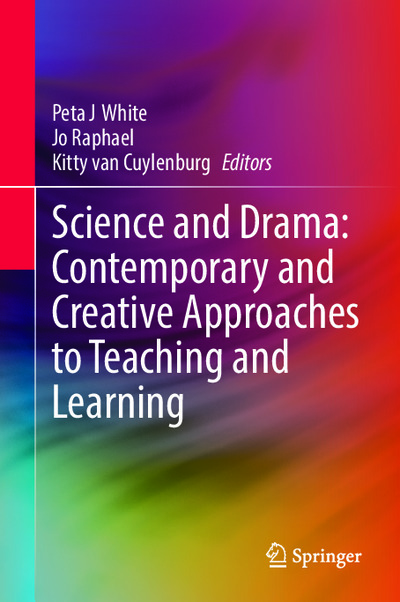Science and DramaContemporary and Creative Approaches to Teaching and Learning
|

|
 Diese Seite wurde seit 2 Jahren inhaltlich nicht mehr aktualisiert.
Unter Umständen ist sie nicht mehr aktuell.
Diese Seite wurde seit 2 Jahren inhaltlich nicht mehr aktualisiert.
Unter Umständen ist sie nicht mehr aktuell.
 Kapitel
Kapitel 
- Sparking Learning in Science and Drama - Setting the Scene (Seite 1 - 25) (Jo Raphael, Peta J White, Kitty van Cuylenburg)


- Mutuality and Inter-relativity of Drama and Science (Seite 27 - 41) (Tricia Clark-Fookes, Senka Henderson)


- The Science Drama Project - Meaning in the Middle (Seite 43 - 56) (Kitty van Cuylenburg)


- The Treatment of Dr. Lister - Investigating and Revisiting a Famous Primary Science-Based Drama (Seite 57 - 71) (Susan Davis)


- Dramatising the S and M in STEM (Seite 73 - 91) (Kathryn Paige, Leni Brown, Lisa O’Keeffe, Robyne Garrett)


- Responding to Climate Change - Developing Primary Children’s Capability to Engage with Science Through Drama (Seite 93 - 105) (Delia Baskerville, Dayle M. Anderson)


- New Eden - Mediating Pre-service Teachers’ Conceptions of Education for Sustainable Development (Seite 107 - 123) (Debbie Myers)


- Ice Age is Approaching - Triggering University Students’ Interest and Engagement in Gamified Outdoor Playful Learning Activities (Seite 125 - 143) (Pirkko Siklander, Sari Harmoinen)


- Transdisciplinarity - Science and Drama Education Developing Teachers for the Future (Seite 145 - 161) (Jo Raphael, Peta J White)


- Art-Science Education in the Anthropocene - Embodied Metaphor with Puppets and Performance (Seite 163 - 178) (Shelley Hannigan, Joseph Ferguson)


- “This is the Funniest Lesson” - The Production of Positive Emotions During Role-Play in the Middle Years Science Classroom (Seite 179 - 196) (Senka Henderson, Donna King)


- Dramatic and Undramatic Emotional Energy - Creating Aesthetic and Emotive Learning Experiences in Science Classrooms (Seite 197 - 209) (James P. Davis)


- Does Being Positioned in an Expert Scientist Role Enhance 11–13 Year-Old Students’ Perceptions of Themselves as Scientists? (Seite 211 - 225) (Carolyn Julie Swanson)


- Stories from History - More Authentic Ways of Thinking Through Acting and Talking About Science (Seite 227 - 241) (Debra McGregor)


- Australian Women in Science - A Model for a Research-Based Theatre Project in Secondary School Classrooms (Seite 243 - 258) (Richard Johnson Sallis, Jane Bird)


- Science, Drama and the Aesthetic (Seite 259 - 272) (Russell Tytler, Vaughan Prain)


 Dieses Buch erwähnt ...
Dieses Buch erwähnt ...
 Personen KB IB clear | Lou Aronica , John Dewey , David Hume , Bruno Latour , Jean Lave , Annie Leonard , Richard Louv , Thomas J. Pilecki , Mitchel Resnick , Sir Ken Robinson , Donald A. Schön , C. P. Snow , David A. (Anthony) Sousa , Lew Semjonowitsch Vygotsky , Etienne Wenger , Steve Woolgar | ||||||||||||||||||||||||||||||||||||||||||||||||||||||||||||||||||||||||||||||||||||||||||||||||||||||||||||
 Begriffe KB IB clear | action researchaction research
,  Aufmerksamkeit / Fokus Aufmerksamkeit / Fokus attention
, attention
,  Beobachtung Beobachtung observation
, Bildungeducation (Bildung)
, Bildung für eine nachhaltige Entwicklung (BNE)education for sustainable development
, observation
, Bildungeducation (Bildung)
, Bildung für eine nachhaltige Entwicklung (BNE)education for sustainable development
,  Biologie Biologie biology
, biology
,  Denken Denken thinking
, thinking
,  Eltern Eltern parents
, parents
,  Emotionen Emotionen emotions
, GamificationGamification
, emotions
, GamificationGamification
,  Innovation Innovation innovation
, innovation
,  Kinder Kinder children
, children
,  Klimawandel
, Klimawandel
,  Kreativität Kreativität creativity
, kulturelles Kapital
, creativity
, kulturelles Kapital
,  LehrerIn LehrerIn teacher
, teacher
,  Lernen Lernen learning
, learning
,  Mathematik Mathematik mathematics
, mathematics
,  MINT MINT science, technology, engineering, mathematics
, science, technology, engineering, mathematics
,  ökologischer Fussabdruck ökologischer Fussabdruck ecological footprint
, ecological footprint
,  Schule Schule school
, scientific literacyscientific literacy
, school
, scientific literacyscientific literacy
,  Wissenschaft Wissenschaft science science
| ||||||||||||||||||||||||||||||||||||||||||||||||||||||||||||||||||||||||||||||||||||||||||||||||||||||||||||
 Bücher |
| ||||||||||||||||||||||||||||||||||||||||||||||||||||||||||||||||||||||||||||||||||||||||||||||||||||||||||||
 Texte |
|
 Dieses Buch erwähnt vermutlich nicht ...
Dieses Buch erwähnt vermutlich nicht ... 
 Tagcloud
Tagcloud
 Zitationsgraph
Zitationsgraph
 Zitationsgraph (Beta-Test mit vis.js)
Zitationsgraph (Beta-Test mit vis.js)
 Zeitleiste
Zeitleiste
 1 Erwähnungen
1 Erwähnungen 
- Das Potential von Physical Computing als Teil von Schultheaterprojekten (Christian Renggli) (2023)

 Volltext dieses Dokuments
Volltext dieses Dokuments
 Anderswo suchen
Anderswo suchen 
 Beat und dieses Buch
Beat und dieses Buch
Beat hat dieses Buch während seiner Zeit am Institut für Medien und Schule (IMS) ins Biblionetz aufgenommen. Beat besitzt kein physisches, aber ein digitales Exemplar. Eine digitale Version ist auf dem Internet verfügbar (s.o.). Aufgrund der vielen Verknüpfungen im Biblionetz scheint er sich intensiver damit befasst zu haben. Es gibt bisher nur wenige Objekte im Biblionetz, die dieses Werk zitieren.

















 , 6407 kByte;
, 6407 kByte;  )
)  Biblionetz-History
Biblionetz-History